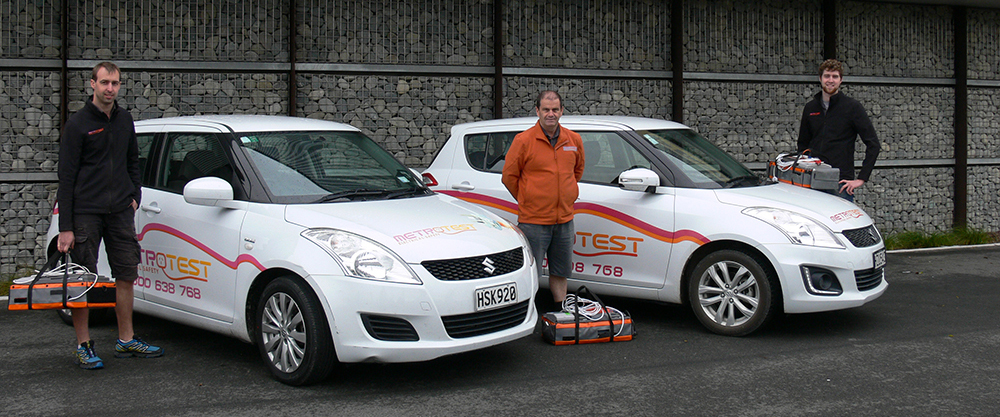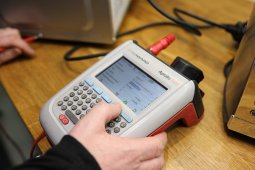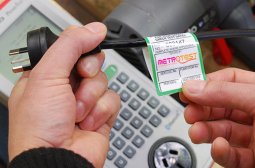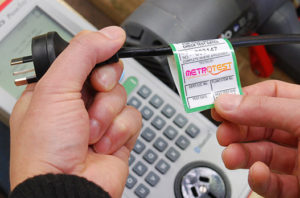
Working near electricity or using electrical appliances is dangerous, and accidents such as electrocution or arc flashes can lead to fatal consequences. To ensure a safe workplace, employers are obligated to have electrical appliances on site inspected and labelled properly.
As per standards and regulations, all electrical equipment, tools and leads sold in New Zealand must be tested on a regular basis – a procedure we know as ‘test and tag’. This reduces the risk to workers using the equipment. Testing and tagging must be carried out by a trained professional, using proper testing tools.
 How often electrical appliances should be inspected depends mainly on the type of environment where they are used or located. The general guidelines are as follows:
How often electrical appliances should be inspected depends mainly on the type of environment where they are used or located. The general guidelines are as follows:
- New appliances – before initial use
- Building sites –every three months
- Factories – every six months
- Commercial workplaces, offices and most other applications – yearly or up to 5 years in some situations.
The AS/NZ 3760:2010 (Table 4) sets the minimum required standard interval for test and tag frequency in New Zealand. The frequencies may vary according to each workplace’s specific risk management practices and OHS planning.
Table 4: AS/NZ 3760 Test and Tag Intervals
Type of Environment and/or Equipment
(a)
1. Factories, workshops,places of manufacture,assembly, maintenance or fabrication
2. Environment were the equipment or supply flexible cord is subject to flexing in normal use OR is open to abuse OR is in a hostile environment
3. Environment were the equipment or supply cord is NOT subject to flexing in normal use and si NOT open to abuse and is NOT in a hostile environment
4. Residential type areas of: hotels, residential institutions, motels, boarding houses, halls,hostels, accommodation houses, and the like
5. Equipment used for commercial cleaning
6. Hire equipment: Inspection Test and tag
Interval between inspection and tests
Equipment including
Class I equipment, Class II
equipment, cord sets, cord
extension sets and EPODs
(b)
6 months
12 months
5 years
2 years
6 months
Residual Current Devices (RCDs)
Push-button test – by user
Portable (c)
Daily, or before every use, whichever is the longer
3 months
3 months
6 months
Daily, or before every use,whichever is the longer
Including push-button test by hirer prior to hire
N/A
Fixed (d)
6 months
6 months
6 months
6 months
N/A
Including push-button test by hirer prior to hire
N/A
Operating time and push-button test
Portable (e)
12 months
12 months
2 years
2 years
6 months
Fixed (f)
12 months
12 months
2 years
2 years
N/A
7. Repaired, serviced and second-hand equipment
After repair or service which could affect electrical safety, or on reintroduction to sercie, refer to AS/NZS 5762
Type of Environment and/or Equipment (a)
1. Factories, workshops, places of work or repair, manufacturing, assembly, maintenance or fabrication
Interval between inspection and tests
Equipment including Class I equipment, Class II equipment, cord sets, cord extension sets and EPODs (b)
6 months
Residual Current Devices (RCDs)
Push-button test – by user
Portable (c)
Daily, or before every use, whichever is the longer
Operating time and push-button test
Type of Environment and/or Equipment (a)
2. Environment were the equipment or supply flexible cord is subject to flexing in normal use OR is open to abuse OR is in a hostile environment
Interval between inspection and tests
Equipment including Class I equipment, Class II equipment, cord sets, cord extension sets and EPODs (b)
12 months
Residual Current Devices (RCDs)
Push-button test – by user
Operating time and push-button test
Type of Environment and/or Equipment (a)
3. Environment were the equipment or supply cord is NOT subject to flexing in normal use and si NOT open to abuse and is NOT in a hostile environment
Interval between inspection and tests
Equipment including Class I equipment, Class II equipment, cord sets, cord extension sets and EPODs (b)
5 years
Residual Current Devices (RCDs)
Push-button test – by user
Operating time and push-button test
Type of Environment and/or Equipment (a)
4. Residential type areas of: hotels, residential institutions, motels, boarding houses, halls,hostels, accommodation houses, and the like
Interval between inspection and tests
Equipment including Class I equipment, Class II equipment, cord sets, cord extension sets and EPODs (b)
2 years
Residual Current Devices (RCDs)
Push-button test – by user
Operating time and push-button test
Type of Environment and/or Equipment (a)
5. Equipment used for commercial cleaning
Interval between inspection and tests
Equipment including Class I equipment, Class II equipment, cord sets, cord extension sets and EPODs (b)
6 months
Residual Current Devices (RCDs)
Push-button test – by user
Portable (c)
Daily, or before every use,whichever is the longer
Operating time and push-button test
Type of Environment and/or Equipment (a)
6. Hire equipment: Inspection Test and tag
Interval between inspection and tests
Equipment including Class I equipment, Class II equipment, cord sets, cord extension sets and EPODs (b)
Residual Current Devices (RCDs)
Push-button test – by user
Portable (c)
Including push-button test by hirer prior to hire
N/A
Fixed (d)
Including push-button test by hirer prior to hire
N/A
Operating time and push-button test
Type of Environment and/or Equipment (a)
7. Repaired, serviced and second-hand equipment
Interval between inspection and tests
Equipment including Class I equipment, Class II equipment, cord sets, cord extension sets and EPODs (b)
After repair or service which could affect electrical safety, or on reintroduction to sercie, refer to AS/NZS 5762
Residual Current Devices (RCDs)
Push-button test – by user
Operating time and push-button test
Portable (c)
Fixed (d)
Portable (e)
Fixed (f)
After repair or service which could affect electrical safety, or on reintroduction to sercie, refer to AS/NZS 5762
The hostile environment referred to in the table include exposure to conditions of heat, moisture, vibration, corrosive chemicals and mechanical damage.
Electrical testing standards
In addition to following the standard inspection time intervals, you need to make sure that the procedure meets all requirements set out by AS/NZS 3760:2010 for:
- testing the equipment,
- tagging equipment once they have been tested, and
- recording the test results of the expected life of the appliance.
Schedule 4 of the Electrical (Safety) Regulations 2010 lists recognised standards for all commonly available electrical products. All other standards not specifically stated can be found on Schedule 2 of the Regulations under AS/NZ 3820 – Essential Safety Requirements for Electrical Equipment.
Where an appliance is found to be faulty, it should immediately be tagged as “out of action” until necessary repairs are done by a professional.
What kind of equipment must be tested?
- All equipment that are plugged into the low voltage power supply
- Portable outlet devices or power boards
- Portable transformers
- Portably heavy-duty tools
- Residual current devices
- Battery chargers
- Flexible cords that are connected to equipment in high-risk environments, such as laboratories
Other devices or appliances that fall under the following conditions don’t require testing:
- Equipment that is fixed or wired directly into the wall.
- Equipment that would require dismantling to be tested.
- Light fittings suspended from the ceiling or similar electrical products that are unlikely to get anyone electrocuted upon touching.
- LAN cabling or mains outlets.
How much does testing cost?
Test and tag specialists typically charge an hourly rate or by the item. You can check online to get a feel for how much is a reasonable fee. Alternatively, you can control your costs by buying your own portable appliance tester (PAT) and having a staff member trained to do the testing.
Only a ‘competent’ person can carry out in-service inspection and testing of electrical appliances. In order to become competent in test and tag work, a person must be able to prove competency through training, knowledge or a combination of both. The best way to do this would be to attend a test and tag competency course.
If you have a lot of equipment to be tested every so often, having a staff member take a test and tag training course is a small investment that will save you a lot of money later on. Furthermore, you will not only ensure the safety of your employees but you’ll also avoid the risk of non-compliance.

 How often electrical appliances should be inspected depends mainly on the type of environment where they are used or located. The general guidelines are as follows:
How often electrical appliances should be inspected depends mainly on the type of environment where they are used or located. The general guidelines are as follows:


 Being competent in testing and tagging comes with a number of benefits:
Being competent in testing and tagging comes with a number of benefits:








